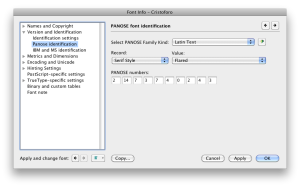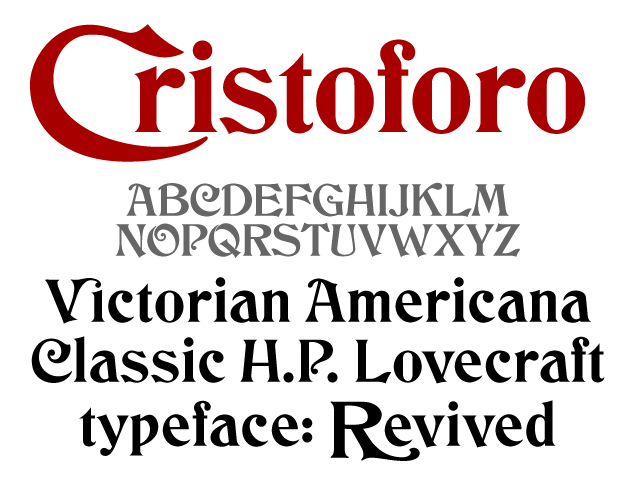[Updated June 1 & May 29 on deadline and minor details, May 26 on time/duties/pay, previously May 6 on funding chances, possibility of part-time, clarified total working hours, and discussed what will happen if the Kickstarter campaign fails.]
General
Deadline for applications: 2 pm PST, Saturday June 2nd. (Though earlier is better, interviewing the week of May 29th.)
I’m looking for a type design intern, probably just for the summer, though I’m open to a longer period. This will be an unpaid position, but with an unusually good ratio of learning-plus-even-working-on-your-own-projects to ruthless exploitation. The duties of the position will be dependent on the success of the Kickstarter funding campaign for the Cristoforo typeface. I expect the project will be funded, but without enough money for a stipend. Assume it’s unpaid and you won’t be disappointed.
If the Kickstarter campaign fails? I am still considering that. I may still proceed to work on the typeface just to get it done. It’s nice to finish things. That would eliminate most of the graphic design work in the position, as that was all for the “rewards” for Kickstarter backers. I might still do the desktop wallpapers, and just maybe digitally printed T-shirts. It would also make a part-time situation make more sense, with less total work and less time pressure involved.
Details
I’m located in Portland, Oregon. Helpful if you are too, or willing to relocate for the summer.
I’m open to negotiation, but as a starting point, I envision this position as roughly equal parts of the following areas of work:
- Helping me with font production on Cristoforo (in process) and especially Cristoforo Italic (not even started). There is room for some actual type design here.
- Helping create and deliver the rewards for the Cristoforo Kickstarter project (t-shirt, poster, 3 desktop designs; taking the lead on design, if possible)
- Reading suggested books from my substantial library on typography and type design. Expect to read at least one book every week, more if possible.
- Working on your own type design project(s) much as you would if you were doing a University course
- Receiving direct type design instruction as well as detailed and constructive feedback and critiques from me on your work, both on your own type design project and your help on Cristoforo
I initially viewed this as totaling a full-time position, but I had concerns that I will have enough work to keep my intern busy, given the limitations on my own time. Part-time is more plausible, maybe 15-25 hours a week. Mind you, it depends on how much you can do on your own type design as well.
The position will start in June. It could be remote initially if you are coming out later.
Salary is unlikely. If the Kickstarter campaign exceeds its funding target, then half the excess will go to my intern. It probably won’t be much, but I am hopeful the fringe benefits will compensate.
If you are working with me in Portland, you would likely be spending a significant amount of time in the finished basement of my home, in a small office area. (Perhaps not my existing home office space, we might take over the storage area for more space!) You’ll have a 24“ monitor to work with, and if you don’t have your own laptop I will provide a Windows laptop to use with the monitor. We could also meet elsewhere, as long as it is not too distant from my SE location.
I do not discriminate on the basis of age, race, gender/identification, sexual orientation, national origin, etc. If you do, we might not be the best match.
Requirements:
- Obsessive, detail-oriented personality
- Strong ability to follow through and finish lengthy projects
- Comfortable and able to both work substantially independently (for your own type design) and with considerable guidance/interference/supervision (on Cristoforo and possibly on the Kickstarter rewards).
- Some background in typography and graphic design
- Quick learner
- Very good English reading skills or ability to put in extra hours to make up for it
- Fair spoken English communication skills
- Solid computer skills. I am happy to teach type design and font production, but you need to be good on a computer already
- Either bring your own laptop or be happy working on Windows
- Be really sharp—brainpower is good.
- Able to work evenings and especially weekends. That’s when I’m free—though much work could also be done during weekdays when I’m busy at my day job. I am not talking about working more than 40 hours a week, it is a question of when we meet and work together.
Highly Desirable:
- Able to relocate to Portland, at least for the summer. If not, we’d be doing a bunch of work by Skype and email and such. But a local (or relocatable) candidate would be preferred.
- Substantial graphic design skill/experience, able to take the lead in designing the poster, t-shirt, and desktop designs called for by the Kickstarter project. BFA in design, or working on a BFA, or equivalent experience, would be great.
- Do not require a special visa to work in the USA, or are willing to work for free. I am not inclined to deal with US visa/immigration bureaucracy unless you are an extraordinary candidate (in which case you ought to be getting paid more than I can afford to pay you!)
Bonus Points For:
- Quite comfortable with both Mac and Windows. I go both ways and my main box right now is a Mac.
- Have your own laptop to bring with you
- Have done noticeable reading or have real experience relating to type design
- Have some familiarity with FontLab Studio or other font development software (CorelDraw does not count)
- Experience with screen printing and/or letterpress printing
- Being a geeky intellectual type
Next Steps:
Submit a resume, write-up, or whatever you like. References appreciated! Samples of, or links to, your previous work would be great, especially anything that shows your attention to detail and ability to complete long projects. If you have done any type design or font production, I’d like to see the actual font file, along with any comments you have on things you think are good and things that you know need work.
My email address is tphinney and the domain is cal.berkeley.edu.




